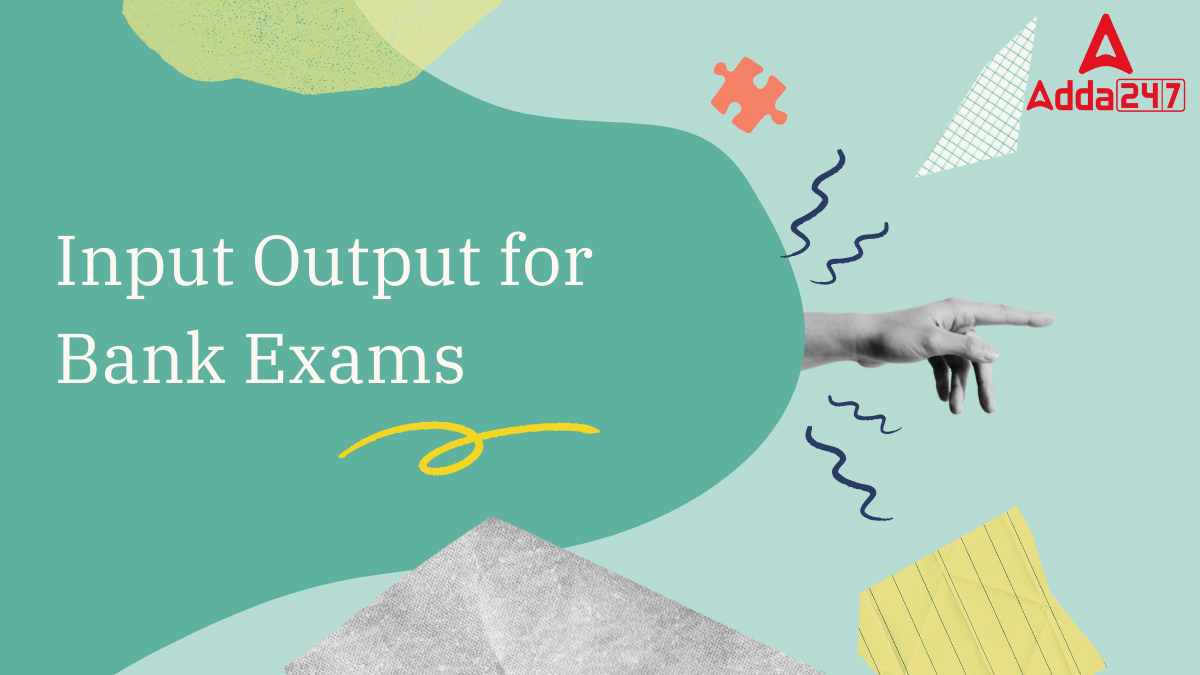Table of Contents
Input-Output is an important section in the reasoning ability section of bank exams like IBPS PO, SBI PO, RBI Assistant, IBPS Clerk and others. This topic tests a candidate’s ability to understand patterns and logically rearrange or manipulate a given set of data based on specific rules. Input-Output questions can significantly boost your overall score in the reasoning section, as they are typically less time-consuming once understood.
Input Output for Bank Exams
Input-output questions are a critical part of the reasoning ability section in bank exams. With consistent practice, understanding of the rules, and speed, candidates can solve these questions quickly and accurately.
Input-Output Reasoning: Types of Questions
Here are the common types of Input-Output reasoning questions that a candidate might encounter in bank exams:
Rearrangement-Based Ordering: In these questions, a series of words or numbers are rearranged alphabetically (either forward or reversed). Candidates are required to arrange both words and numbers simultaneously in each step. This type of question often follows a predictable pattern and can be solved quickly once the rule is recognized.
Based on Interchanging Positions and Numbers: In this type, specific positions of numbers or words are interchanged while the remaining elements stay in place. Identifying the pattern of interchange will allow you to solve the problem systematically.
Based on Mathematical Operations: These questions involve applying basic mathematical operations like addition, subtraction, multiplication, or division in each step. The operations are applied either to numbers directly or to characters based on their ASCII values.
Based on Single Shift: Here, the letters, numbers, or alphanumeric series are rearranged from one end only, either from the right end or the left end. Understanding whether the shift happens from one specific end can help you solve the question faster.
Based on double-shifting: In double-shifting questions, letters or numbers are arranged from both ends simultaneously—right and left. These questions might appear tricky but become easier once the shifting pattern is identified.
Based on Box Arrangement: In these questions, numbers and letters are placed in boxes, and the arrangement follows a rule applied to each step. Candidates must figure out the operation applied to the elements inside the boxes to correctly predict the next steps.
Common Patterns in Input-Output Questions
Alphabetical Rearrangement: The most common pattern in word-based Input-Output questions involves rearranging words in alphabetical order. Candidates may be asked to arrange words alphabetically in either ascending (A-Z) or descending (Z-A) order.
Numerical Rearrangement: For number-based Input-Output questions, the numbers may be rearranged in increasing or decreasing order. There may also be additional operations such as adding or subtracting a constant value from each number.
Positional Shifts: Some questions require shifting the positions of words or numbers based on a set rule. For instance, the largest number may be moved to the first position, the second largest to the last position, and so on. Identifying these shifts early will allow candidates to solve the question quickly.
Alphanumeric Manipulation: A combination of letters and numbers might be given, with alternating steps requiring changes to the numbers and letters based on specific rules. For example, numbers might be arranged in descending order while words are arranged alphabetically.
Approach to Solving Questions of Input-Output for Bank Exams
Understand the Pattern: Carefully observe the pattern between the input and output. The first step is crucial because once you understand the rule applied in this step, you can predict subsequent steps more easily.
Work Methodically: Write down each step clearly and avoid skipping any. A systematic approach ensures you won’t miss key elements or steps in the sequence.
Visualize the Shifts: Try to visualize how the elements (numbers or words) are moving in each step. Identifying whether the elements shift from one or both ends will help you figure out the final arrangement more quickly.
Skip Full Calculation When Possible: If you notice a clear pattern after solving a few steps, you may be able to skip detailed calculations for the remaining steps and predict the final output directly.
Input Output Questions for Bank Exams
Directions (01-05): In a number arrangement machine when given an input line of numbers, it rearranges them following a particular rule in each step. The following is an illustration of input and rearrangement.
Input: 75 16 56 25 48 31 64 97 22 57
Step I: 52 75 56 48 31 64 97 22 57 17
Step II: 13 52 75 56 48 64 97 57 17 23
Step III: 75 13 52 75 56 64 97 17 23 49
Step IV: 57 75 13 52 64 97 17 23 49 57
Step V: 79 57 75 13 52 17 23 49 57 65
And step V is the last step of the arrangement. As per the above rule followed in the above steps, find out in each of the following questions the appropriate step for the input given below;
Input: 86 14 53 24 45 17 32 27 74 93
Q01. Which of the following is the penultimate step of the above input?
(a) III
(b) VI
(c) IV
(d) V
(e) None of these
Q02. Which is the following step?
Step: 54 72 71 86 53 74 93 15 25 33
(a) VI
(b) III
(c) IV
(d) V
(e) There is no such step
Q03. What is 4th element from the right end in Step IV?
(a) 15
(b) 71
(c) 86
(d) 93
(e) 54
Q04. Which of the following elements lies exactly between 71 and 32 in step II?
(a) 15
(b) 86
(c) 53
(d) 25
(e) 74
Q05. Which of the following is the fifth step for the given input?
(a) 39 15 25 33 75 87 35 54 72 71
(b) 39 35 25 33 75 87 54 72 71 15
(c) 39 72 71 15 25 33 35 54 75 87
(d) 71 15 25 33 75 87 39 35 54 72
(e) 39 35 54 72 71 15 25 33 75 87
Solutions (01-05): In this input-output question two numbers are arranged in each step following a certain pattern. Let us understand the logic behind it-
* Even numbers are arranged at the right end, from left to right in ascending order after adding one to each number (Numbers are picked from lowest to highest).
* Odd numbers are arranged at the left end, from right to left in ascending order after the digits are interchanged within the number (Numbers are picked from lowest to highest).
Input: 86 14 53 24 45 17 32 27 74 93
Step I: 71 86 53 24 45 32 27 74 93 15
Step II: 72 71 86 53 45 32 74 93 15 25
Step III: 54 72 71 86 53 74 93 15 25 33
Step IV: 35 54 72 71 86 93 15 25 33 75
Step V: 39 35 54 72 71 15 25 33 75 87
S01. Ans.(c)
S02. Ans.(b)
S03. Ans.(a)
S04. Ans.(c)
S05. Ans.(e)




 GA Capsule for SBI Clerk Mains 2025, Dow...
GA Capsule for SBI Clerk Mains 2025, Dow...
 The Hindu Review October 2022: Download ...
The Hindu Review October 2022: Download ...
 IBPS PO Syllabus 2025 and Exam Pattern f...
IBPS PO Syllabus 2025 and Exam Pattern f...




